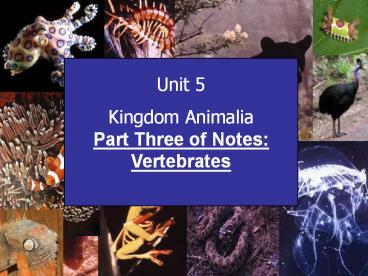The Animal Kingdom - PowerPoint PPT Presentation
Title:
The Animal Kingdom
Description:
Unit 5 Kingdom Animalia Part Three of Notes: Vertebrates* – PowerPoint PPT presentation
Number of Views:177
Avg rating:3.0/5.0
Title: The Animal Kingdom
1
Unit 5 Kingdom Animalia Part Three of
Notes Vertebrates
2
- _______________
3
- Vertebrates
- Vertebrates
- ________
- Amphibians
- ________
- Birds
- Mammals
4
Vertebrates
- Have a ______________
- Have well-developed ___________ protected by a
_________ - Have an ________________
- -endoskeleton an internal support system
(_______________)
5
Vertebrates
- Can be ___________ or _____________
- -exothermic (ectothermic) ______________ an
animal whose body temperature changes with the
OUTSIDE temperature - -endothermic - ________________ - an animal
whose body temperature remains _________, no
matter what the outside temperature is
6
WORMS
- FISH
7
___________ Characteristics
- ______________ of vertebrates
- Ectothermic - rely on the environment to
regulate body temperature - Breathe through __________
- Have _________________
- Have swim bladder which allows the fish to adjust
to the depth at which it floats - Have a _____________ which is a sensory organ
that allows the fish to sense ___________from
objects and other organisms around them
8
_________ - Adaptations
- Lateral Line to sense _________ ________________
- Swim Bladder to help it get prey and escape from
predators - ___________________
- Gills for breathing
- Fins to help it swim
- ________________________ female fish release
eggs into the water where they are fertilized by
sperm (____________________)
9
3 Groups of Fish
- ___________________
- -lampreys and hagfish
- 2. ___________________
- -sharks, rays and skates
- 3. ____________________
- -catfish, bass, carp
Lamprey
Hagfish
Ray
Shark
Carp
Catfish
10
Jawless Fish
- Lampreys ___________
11
Cartilaginous Fish
- __________ Rays and Skates
12
____________
13
- AMPHIBIANS
14
Amphibians Characteristics
- First vertebrate to live on _____________
- ___________ - rely on the environment to
regulate body temperature - Smooth, moist skin
- __________
- Examples ______, Salamanders, ______, and
Caecilians
15
Amphibians Characteristics
- _______ return to the water to ___________
- Lay their eggs in water (eggs will dry out if
laid on land) - Undergo _____________
- (Tadpoles breathe with _________ will develop
into a frog breathe with __________)
16
_______________
- _______ are a legless, tailless tropical
amphibian/ Though eel-like or earthworm-like in
appearance, they are neither of these. They have
_______ characteristics such as _______ and
_______ . Their eyes are nearly functionless and
even non-existant on some.
17
_______________
18
______________________
19
- REPTILES
20
Reptiles Characteristics
- Reptiles evolved (changed over time) from
____________ by adapting to life on _________ - __________
- Scaly, dry skin
- __________
- _________ egg can survive on land and not dry
out
21
____________________
- Dry, scaly skin
- ___________
- Adapted to living on land
- Lay eggs that have tough, ________________
22
_________________ Examples
- Snakes Lizards
- Turtles/Tortoises Alligators/Crocodiles
23
- BIRDS
24
_____________ Characteristics
- ___________ maintain a constant body
temperature (homeostasis) - _____________
- Most fly
- Have a ______________
- Have 4 limbs (2 legs and 2 wings)
- Amniotic eggs with hard shell
- ______________________
25
______________________
- _______ (make them light)
- Hard beaks or bills to get food
- Feathers (support flight)
- ________
26
- MAMMALS
27
_______________ Characteristics
- _______ maintain a constant body temperature
(homeostasis) - ____________
- Produce milk in mammary glands
- Specialized teeth
- Most give birth to ____________
- Most have a placenta that gives the developing
___________________ - Reproduce sexually/Internal fertilization
28
Mammals Adaptations
- ________________
- Specialized Limbs
29
3 Groups of Mammals
- Monotremes _______________
- ___________ _____________________
- ___________ all others































